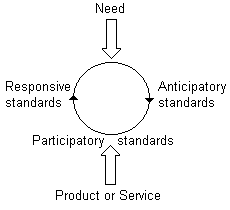Responsive Standards
E. Baskin, K. Krechmer and M. H. Sherif. The six dimensions of Standards: Contribution towards a theory of standardization. Management of Technology, Sustainable Development and Eco-Efficiency, Edited by Louis A. Lefebvre, Robert M. Mason and Tarek Khalil, Elsevier Press, Amsterdam, 1998, p. 53.
Respondive standards occur to codify a product or service that has been sold with some success. When a stand-alone product is well entrenched there may be no incentive to standardise.
Responsive standards offer a systematic way of distilling scientific information and available data into useful technical constructs.
Responsive standards mean however, that the initial manufacturer will have to contribute to the standards development, in addition to developing a product. They may have to release technical information earlier than anticipated or modify future product plans. In addition, product differentiation will have to shift to areas not covered by the standard.
The options available to the initial manufacturer who chooses to support a responsive standard are:
- Achieve the maximum market penetration prior to supporting a responsive standard.
- Enhance the product beyond the standardized levels of functionality.
- Differentiate the product based on quality, customer support, or services.
Standardization within the product cycle:

